-
Introduction
Low Force Stereolithography
The guidelines below were developed using Formlabs Grey V4 Resin printing at 100 microns on Form 3. You may experience slight variations with other Formlabs resins, different Formlabs printers, and layer thicknesses.
-
Minimum Supported Wall Thickness

Recommended: 0.2 mm / 200 microns
A supported wall is one that is connected to other walls on two or more sides. A supported wall with a thickness of 0.2 mm or less may warp due to the peel forces exerted on the part during the peel process.NOTE:
Take care when washing parts with thin walls, which may absorb solvents such as IPA during the washing process. Spending an extended duration in a washing solution can cause deformation of the part, so minimize how long the part is immersed in IPA to limit this effect.
-
Minimum Unsupported Wall Thickness

Recommended: 0.2 mm/200 microns
An unsupported wall is one connected to other walls on fewer than two sides. An unsupported wall with a thickness of 0.2 mm or less may warp or detach from the model during printing.
NOTE:
Take care when washing parts with thin walls, which may absorb solvents such as IPA during the washing process. Spending an extended duration in a washing solution can cause deformation of the part, so minimize how long the part is immersed in IPA to limit this effect.
-
Maximum Unsupported Overhang Length
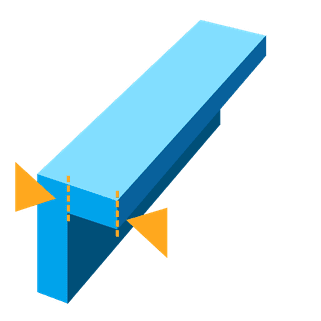
Recommended: 5.0 mm/5000 microns
An overhang refers to a part of the model that extends parallel to the build platform. Printing such features without support is discouraged, as layers that cannot maintain structure often warp or detach. Horizontal overhangs beyond 5 mm do not completely form and become increasingly deformed as the length of the overhang increases. Change the orientation of the model, or click Supports and select Internal Supports in PreForm to ensure overhangs are supported.
Adding internal supports
Internal Supports are any supports with both ends touching the model instead of one end connecting to the raft. Generate supports inside your model to secure overhangs and other hard-to-reach minima.To add internal supports:
- Select the model in PreForm. Manipulators are overlaid on the model.
- Click Supports. A dialogue box opens.
- Select Internal Supports. The box turns blue.
- Click Auto-Generate Selected. Internal supports are added to the selected model.
-
Minimum Unsupported Overhang Angle
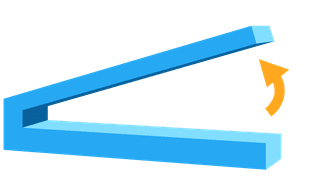
Recommended: 10° from level
(35 mm long × 10 mm wide × 3 mm thick)
An overhang set at an angle of 10 degrees or less can break off the model during the peel process.For additional information about Moving and rotating a model in PreForm to rotate flat surfaces to be more self-supporting, please check the PerForm software guidelines.
-
Maximum Horizontal Support Span Length
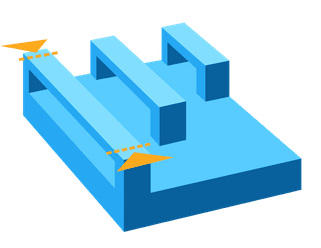
Recommended: 29 mm/29,000 microns
(5 mm width × 3 mm thick)
Span is the distance between two supports. Printing horizontal spans are discouraged, but specific geometries may print successfully. For a 5 mm wide and 3 mm thick beam, spans longer than 29 mm are more likely to fail. Wider beams must be kept shorter to avoid print failures. -
Minimum Vertical-wire Diameter
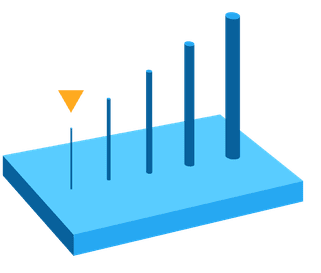
Recommended for a 7 mm-tall wire: 0.2 mm/200-micron diameter
Recommended for a 30 mm-tall wire: 1.5 mm/1500 micron diameterA wire is a feature whose length is at least twice its width. A wire with a 0.2 mm width can be up to 7 mm tall before it begins to deform. Similarly, a wire with a 1.5 mm width can be up to 30 mm tall before it begins to deform
NOTE: WASHING SMALL WIRES
Take extra care when washing thin wires, as they are weakened by IPA and can easily be damaged. Minimizing how long the part is immersed in IPA limits this effect. -
Minimum Embossed Detail
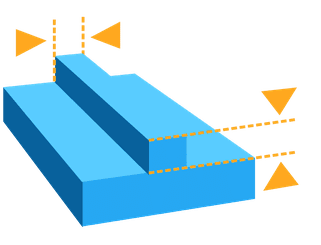
Recommended: 0.1 mm/100 microns
Embossed details are shallow raised features on the surface of a model-like text. Details less than 0.1 mm thick and 0.1 mm tall may not be visible on the completed print. -
Minimum Engraved Detail
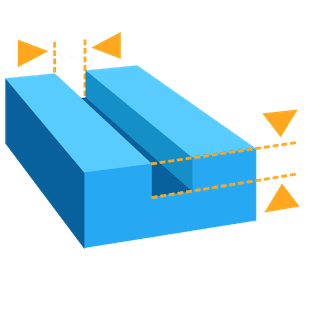
Recommended: 0.15 mm/150 microns
Engraved details are imprinted or recessed features on the surface of a model. Details recessed less than 0.15 mm deep or 0.15 mm wide may fuse with the rest of the model during printing.
-
Minimum Clearance

Recommended: 0.5 mm/500 microns
Clearance is the distance between two parts of a model (e.g., the distance between a pair of gears). Parts may fuse if clearance is less than 0.5 mm.
-
Minimum Hole Diameter
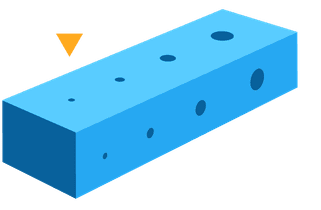
Recommended: 0.5 mm/500 microns
Holes with less than 0.5 mm diameter in the X-, Y-, and Z-axes may close during printing.
-
Minimum Drain Hole Diameter
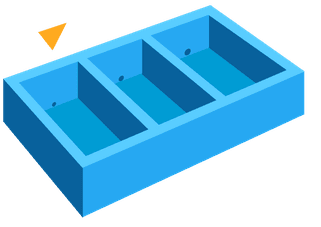
Recommended: 2.5 mm/2500 micron diameter
Drain holes are recommended for resin to escape in models that are a fully enclosed cavity (like a hollow sphere or hollow cylinder printed directly on the build platform). Without drain holes of at least 2.5 mm in diameter, the part may trap resin or air and lead to a cupping blowout failure.
Skip to content
Low Force Stereolithography™ (LFS) Design Guideline
Considerations & best practices for 3D printing with Formlabs®’s Form 3L & Form 3BL